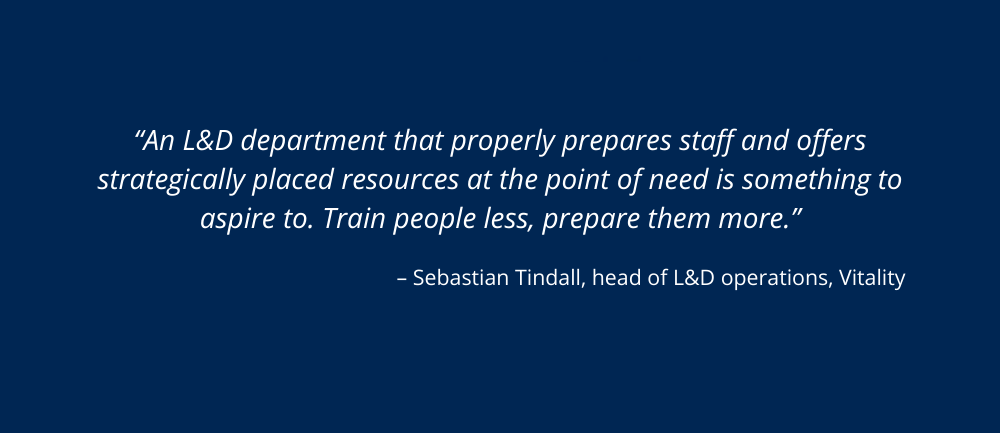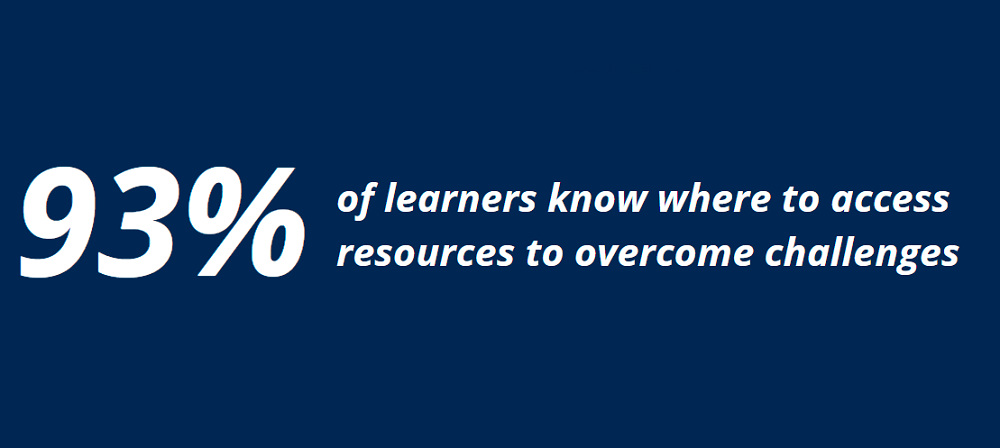-
Provided by

- Date published: Mar 24, 2021
- Categories
As part of Vitality’s core purpose, the insurance service provides medical care and a ‘better health’ element, in which they work with multiple partners to incentivise healthy living. By embracing operational principles like innovation and agility, plus keeping pace with changes in the medical field and partner offerings, Vitality’s staff must continually refine their skills and knowledge.
This requires the L&D team to react in efficient and effective ways to enable the business to continue to thrive. However, rather than continuing to implement traditional approaches to developing staff, instead Vitality decided to apply innovative R&D principles to the L&D space. They decided to completely change the way that they developed and trained people, ensuring that learnings would be up to date and relevant to professional development.
In this case study, Sebastian Tindall, head of L&D operations at Vitality, outlines how the company overhauled its L&D processes to make it a catalyst for change within the organisation.
Assessing the efficacy challenge
Time is a precious commodity and Vitality knew that investing large volumes of it on traditional, inefficient single learning events wasn’t going to yield the results it desired. Instead, the L&D team pivoted its approach to measuring one key metric: efficacy.
In modernising L&D, it’s vital to recognise longstanding issues; for instance, many L&D departments might express that they have delivered 1,000 hours of training per quarter, but hours trained is an input and not an output. An L&D department that properly prepares staff and offers strategically placed resources at the point of need is something to aspire to; train people less, prepare them more – that is the ultimate demonstration of efficacy.
The Vitality L&D team conducts an in-depth evaluation for every deployment, but at its highest level it focuses on four simple metrics:
– Number of training minutes required per project, with the aim to reduce
– Projects per month for the department, with the aim to increase
– After a change has occurred, the learners felt retrospectively prepared, with the aim to improve
– Learners knew where to go if they got stuck, with the aim to improve
With ever-increasing efficacy, it can broaden its reach and consult on an ever-growing number of performance issues across the organisation.
Redesigning L&D operations
This has been a three-year journey that started with redesigning the way that the L&D team consulted on projects. The team had already adapted to agile ways of working, incorporated iterative practices and consistent in-project evaluation, but there was still something missing. The focus of the agile project delivery was around a minimum viable product in a training context, but they realised instead the focus should be on performance as the desired product.

The team went on to create a custom analysis model that maps elements of the performer’s environment, the usability of processes that they follow, the corrective mechanisms in place and any perceived knowledge gaps.
This allowed the team to create a holistic overview of the barriers to desired performance. They can then work with all of the stakeholders to identify a much broader array of potential solutions that can improve performance; if training was part of that solution then so be it, but the singular focus was not on forcing that outcome, and instead what can be done to achieve real business impact quickly. By working closely with product owners, continuous improvement, and ops representatives, they were able to focus on barriers to efficient performance and implement iterative solutions into the workflow to address immediate needs.
Driving change with data
Vitality’s team is challenged to think differently every day; as a result, the environment lends itself well to trying different approaches. However, the L&D team knew that even in that environment, presenting a proposal that suggests that the L&D team is focusing on training people less could prove to be tough sell, so it approached the presentation in a different way.
It made the changes to its consultation process first and achieved a solid data set, which allowed a presentation of a new process to be set against actual achievements, rather anticipated ones. A change is made and then the value is demonstrated, rather than tell people what it might do for them. The team was able to share how, despite the reduction in training minutes utilised, the evaluation metrics had increased.
By keep the evaluation metrics in a similar format to the approach to projects, then you are comparing like for like; the only difference is that you are taking people away from their jobs less. This resonates with most people in the business, whether in the C-suite or not, professionals want to feel like they can still complete their workload and feel supported in doing so.
Measuring the outcome

Over the course of the last two years, the L&D team has reduced the number of training minutes it uses per project on a rolling 12-month basis by 64%, but it has preserved its high level evaluation metrics. Learners that felt that they were prepared for a change four weeks after it happens now sits at 98% (on a rolling 12-month average), learners knowing where to access resources if they got stuck now sits at 93% (on a rolling 12-month average).
This dynamic has allowed the team to triple the number of projects it consults on annually. The project turnaround time, from consultation to delivery of any product, now sits at six working days from the point that a project team has defined a change.
There are still strides to be made and challenges that remain; it’s a tough balance to continually push the levels of efficacy whilst providing the appropriate support, but at this point, the team feels like it has reached a balance that places equal value on commercial results and the learning experience, in this context.
Reflecting on the reforms

We knew what we wanted to do, but it’s a noticeable challenge to change your thinking from a training focus to a performance focus.
It was, and still is, a process of constantly challenging each other to do better, and that is sometimes uncomfortable. It has taken time to turn our custom consultancy process into a more fluid experience for stakeholders.
In the early days we might start a scoping session with questions around what people need to know, but fortunately we have learned a lot and the focus starts with, and stays focused on, what people need to do

